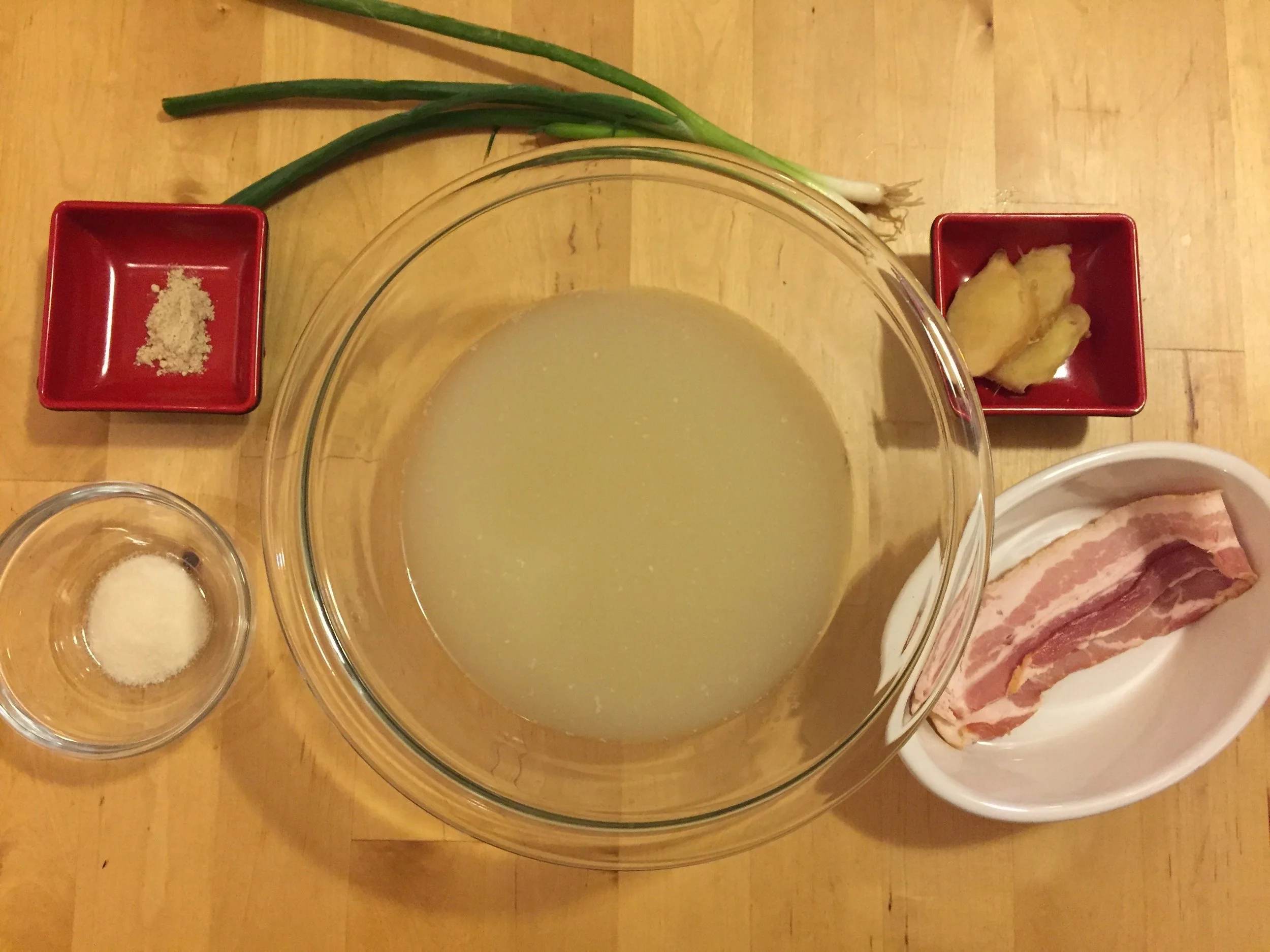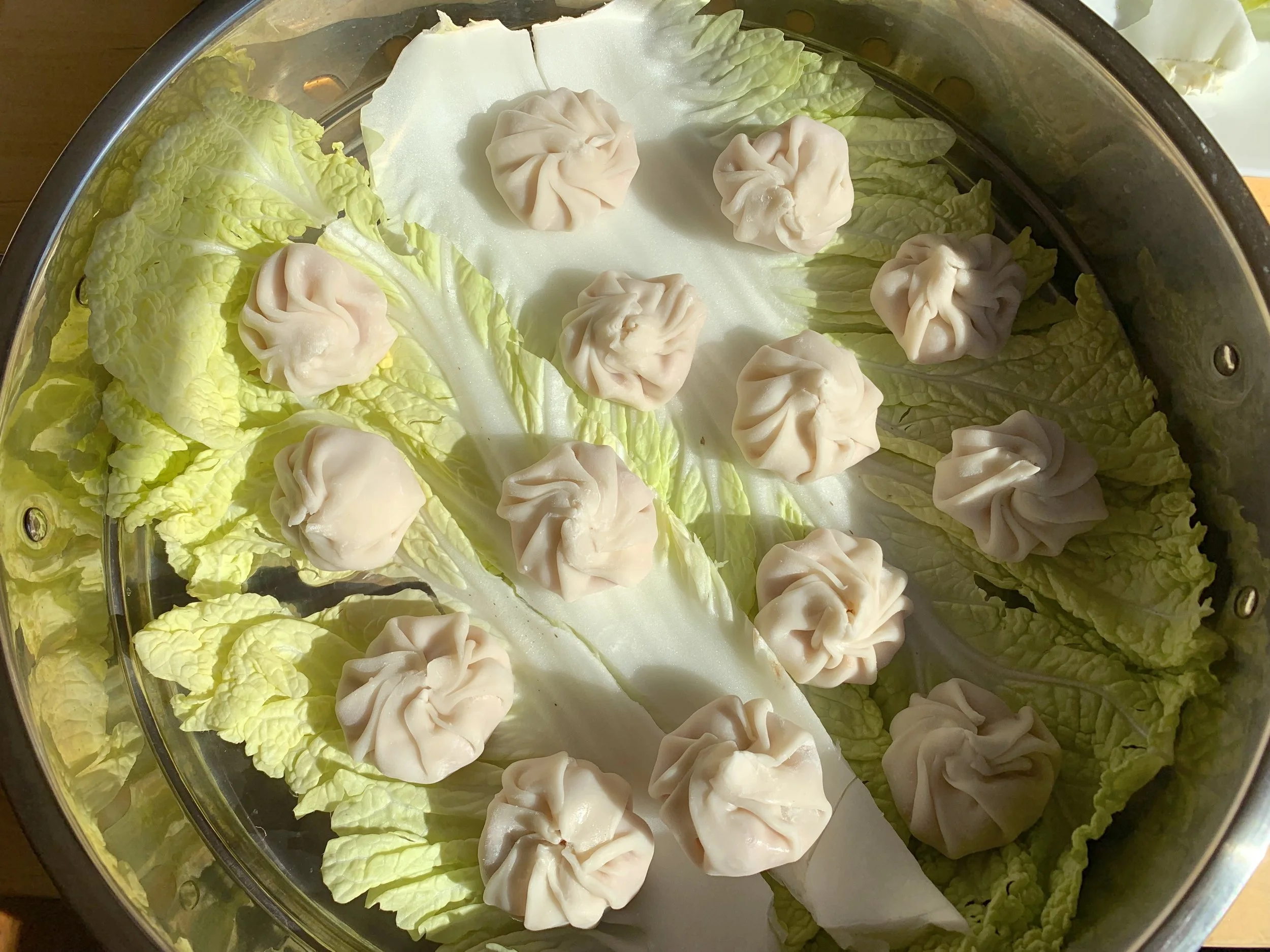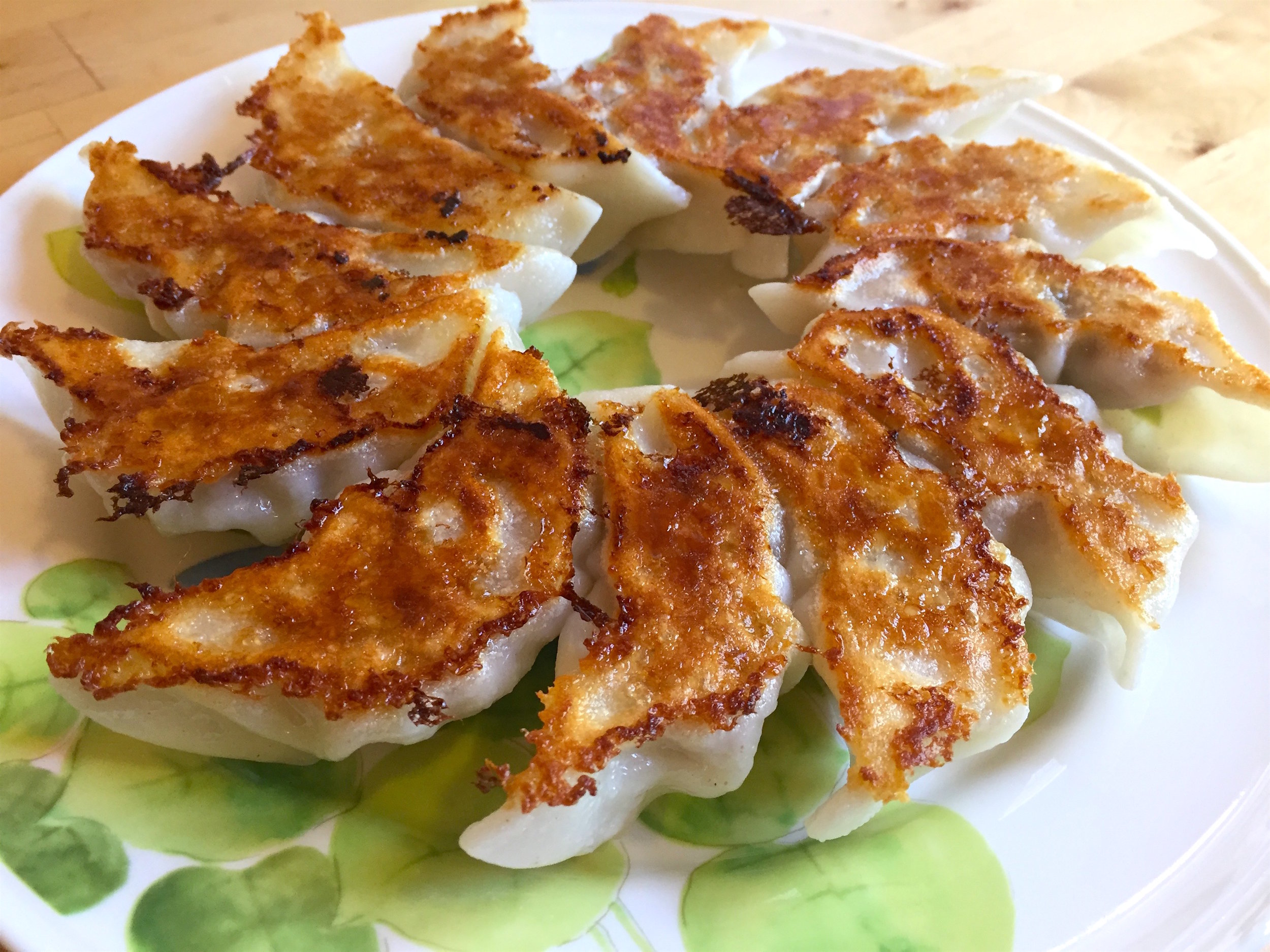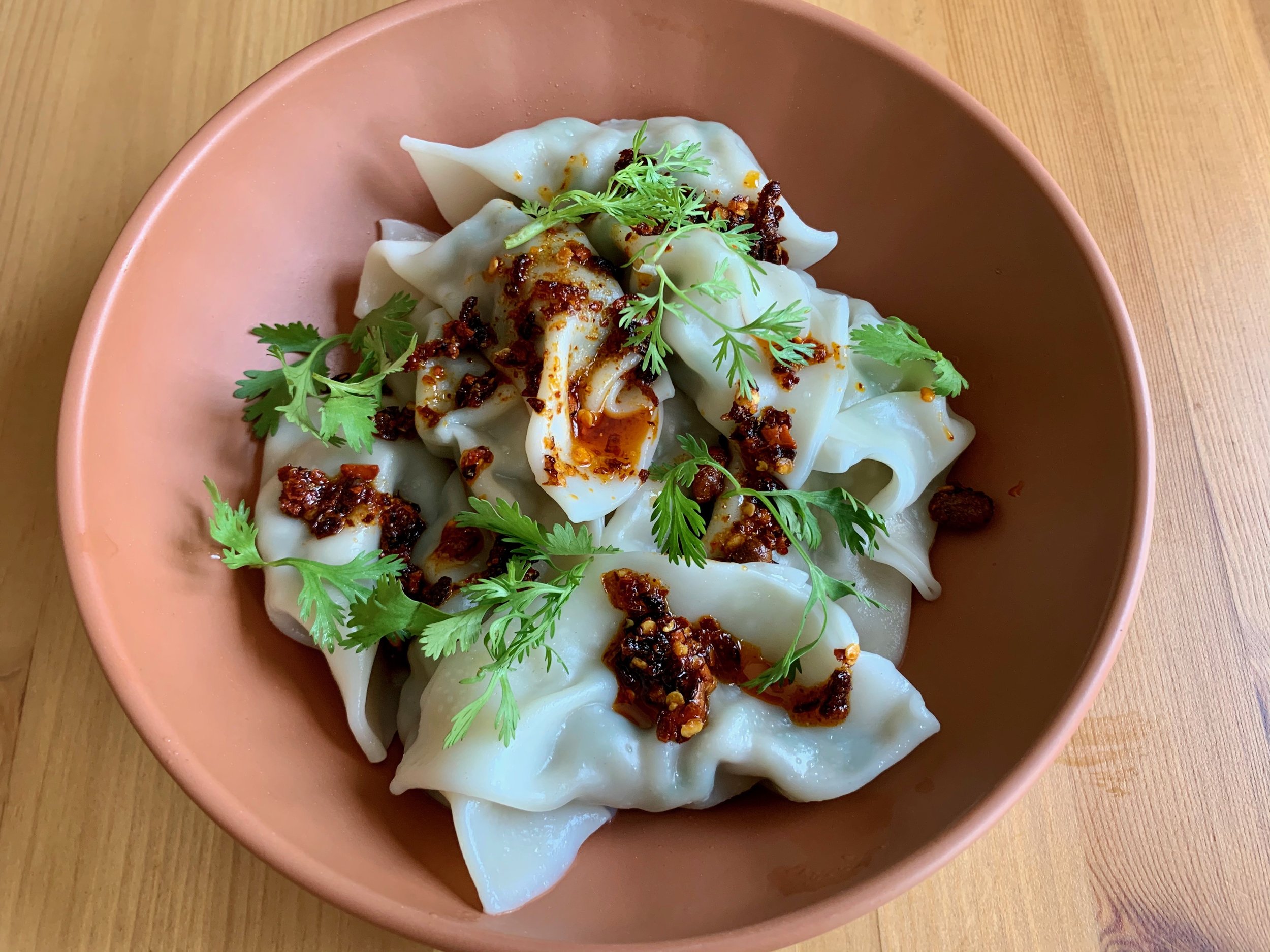Soup Dumplings
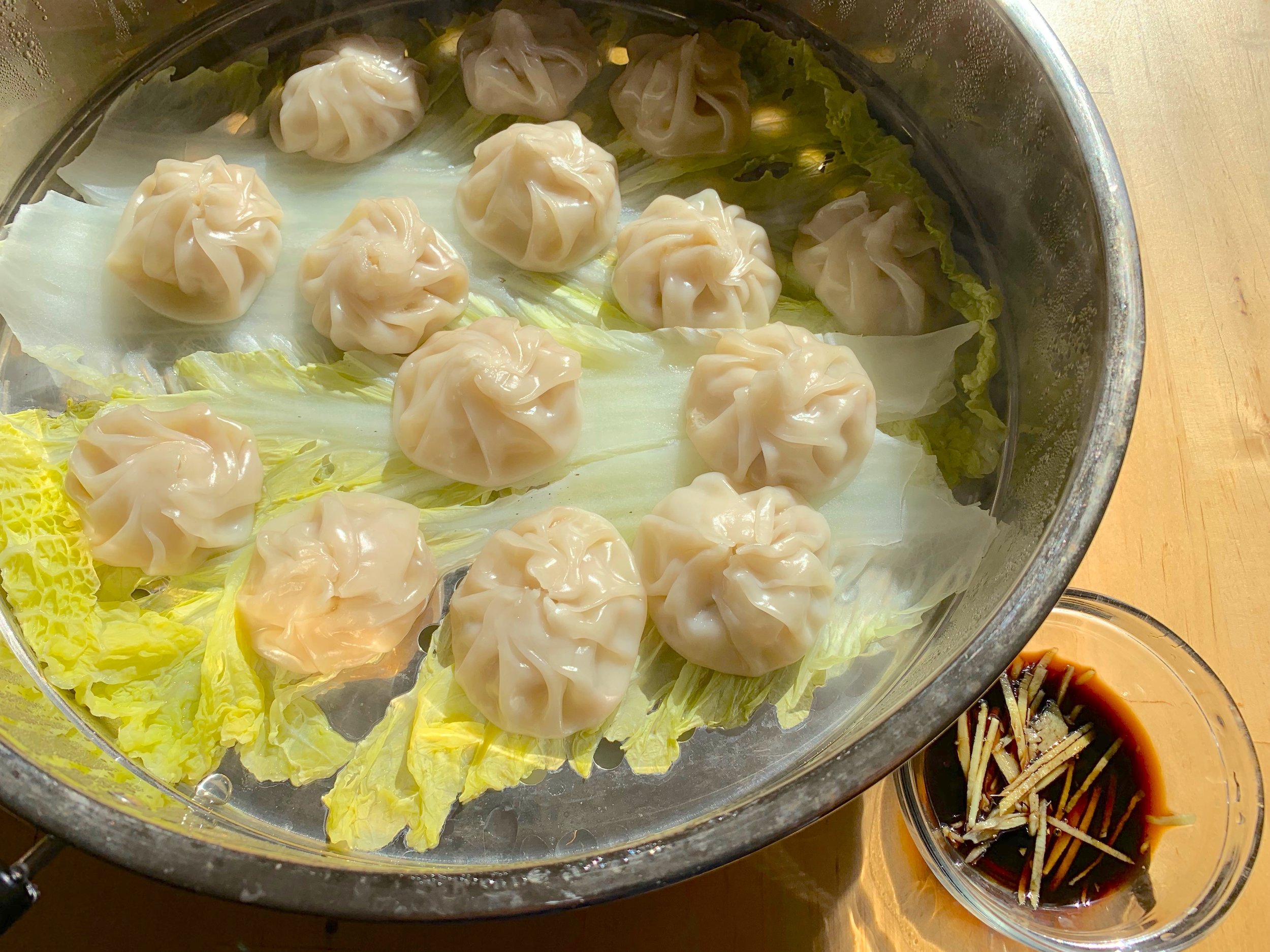
小籠包 (Xiao Long Bao)
Delicate purses of dough filled with tender pork and savory broth, xiao long bao, known in the West as soup dumplings [1], have become one of the iconic dishes of Shanghai. Soup dumplings originated in Nanxiang, a suburb of Shanghai, in the mid 1800s. While pork had been made into steamed dumplings for generations, the innovation of putting soup inside a dumpling was purportedly made by a Nanxiang chef, Huang Mingxian. To get customers in the door to try his revolutionary new dumpling, Chef Huang engaged in a classic bit of false advertising—he called his invention “Nanxiang da rou man tou,” which translates roughly to, “Big pork bun from Nanxiang.” Despite the fact that soup dumplings were neither big, nor, strictly speaking, buns, the new dish was a hit [2,3]. The dish spread quickly through the port city, and from there around the world. Soup dumplings can now be found in Chinese restaurants and dim sum places the world over (though they can vary greatly in quality!).
Soup dumplings are not easy to make at home, but this recipe is a fun exploration of several challenging techniques, and making these yourself gives you the opportunity to control what goes into the food, and to tweak the flavors to your liking.
Ingredients
For the Soup
2 cups pork or chicken stock
1 slice bacon, diced
1 scallion, chopped
½ inch ginger, sliced
¼ tsp white pepper
2 tsp gelatin
The soup dumpling’s identity is derived from the rich broth contained within, and that is where we start this recipe. How can you wrap a spoonful of soup, and contain it in a thin skin? It seems like a magic trick. But as with all magic tricks in this world, soup dumplings are created through nothing more than science and deft hands. There isn’t really any practical way to contain liquids in a flexible dumpling wrapper while trying to seal it, so we need to make the soup a solid. We do this with gelatin [4]. A cube of jellied soup can be wrapped into the dumpling while solid. Then, as the dumpling steams, the soup will undergo a phase change, melting and cooking with the juices of the meat inside to form the broth we slurp out of the end product. In the past, the high concentration of gelatin was achieved by concentrating stock made from many bones and scraps to a very small volume. You can still choose to do it this way, but to give you a sense of the degree of concentration we are talking, we would be looking to get two cups of concentrated stock from about 4-5 pounds of chicken and pork bones, an amount which would normally make multiple gallons of stock.
While I do strongly encourage you to use a homemade pork or chicken stock for this preparation, it seems like a bit of a waste to use so much homemade stock on one dish. Fortunately, we now can get gelatin in powdered or sheet form, which we can add directly to the soup. However, since we are skipping the concentrating step, we have to use other methods to amp up the flavor of our broth.
We’re going to do this by taking two cups of homemade pork or chicken stock, and adding to it a series of flavor boosters—some sliced ginger, a scallion, roughly chopped, some white pepper, and one slice of bacon, diced, for extra pork flavor. Add these ingredients to the stock and bring to a boil in a small pot. Simmer, covered, for about 20 minutes. This should be sufficient to extract the flavor from these ingredients. Strain the soup, removing the solids, and return the soup to the pot. Let the fortified stock cool to room temperature, about 30 minutes. It is important to cool the stock before introducing the gelatin, otherwise the gelatin will not have time to hydrate properly and will instead form lumps.
When the soup is cool, stir in 2 teaspoons of powdered gelatin. Bring to a boil, stirring continuously. Once the soup has boiled, remove it from the heat, and pour the soup into a shallow dish. Cover the dish with plastic wrap and refrigerate until the soup sets into a jelly, about 8-10 hours.
This amount of gelatin will result in a relatively soft jelly, which can be difficult to work with (more of which later). However, more gelatin than this and the soup will not melt properly in the short cook time, resulting in a strange and unpleasant consistency. We are playing a delicate balancing act, trying to create a jellied soup robust enough to wrap with, but soft enough to melt quickly.
Ingredients
For the Filling
1 lb ground pork
2 cups jellied soup, diced
1 inch ginger, minced
2 scallions, minced
4 tsp soy sauce
2 tbsp Shaoxing rice wine
2 tsp brown sugar
2 tsp sesame oil
When the soup has set (likely the next day), we can begin to prepare the rest of the filling. In a large mixing bowl, combine the ground pork with finely minced ginger and scallion, soy sauce, rice wine, brown sugar, and sesame oil. Mix thoroughly, until the filling mixture is homogeneous. Once the meat mixture is ready, it is time to integrate the soup. Throughout the wrapping process, our primary concern is that the soup will melt before it is wrapped. This is of particular concern if it is a hot day. If you feel that the filling and bowl have become too warm while mixing, chill the bowl in the refrigerator for 15 minutes before proceeding.
Cut the soup up into roughly ¼ inch squares (doesn’t have to be exact, just small enough to fit in the dumpling). Using a spatula, carefully lift the soup cubes from the dish where they set, and add them to the filling bowl. With a wooden spoon or spatula, gently fold the soup cubes into the filling. It does not have to be well mixed—we can correct for any inhomogeneities in meat-soup ratio manually when we fill. Chill the combined mixture in the refrigerator for 15 minutes.
Onto wrapping. Set up a wrapping station, with dumpling wrappers, kept covered with plastic or a clean tea towel, a small bowl of water, the filling in a bowl, and a landing zone—a sheet pan or plate lined with parchment paper or plastic wrap. If you think you will be a slow wrapper, it might make sense to scoop some filling out into a small working bowl, leaving the rest in the refrigerator.
Ingredients
For Wrapping and Steaming
1 pkg round dumpling wrappers
Napa cabbage leaves
1 inch ginger, julienned
1 tbsp Chinkiang vinegar
For soup dumplings, it is very important that the wrappers are very soft and flexible, and also not too thick. If the wrappers are too dry, they will crack, and all the soup will leak out. An overly thick wrapper will result in a gummy texture when cooked. Ideally you can source premade dumpling wrappers which are locally made and relatively fresh. If you are unable to find sufficiently high-quality premade dumpling wrappers, you can make your own—follow the recipe here.
The wrapping procedure for soup dumplings is a tricky one. Begin by placing about ¾ of a tablespoon of the filling in the center of the wrapper. Make sure there are at least two soup cubes in the dumpling. With a clean finger dipped in the water, moisten the entire edge of the wrapper. Then make a pinch at the edge to form the first pleat.
Choose a direction—clockwise or counter-clockwise—and then make a second pleat overlapping the first. The two pleats should stick together—if they don’t, add a dab of water to help them adhere. Continue pleating in a circle until you arrive back at the first pleat—we are looking for somewhere in the neighborhood of 12-15 pleats [5].
The dumpling should now somewhat resemble a Medieval purse, with a tight neck. Slowly twist this neck in the direction of the pleats, making sure to get any excess air out of the dumpling—air will expand when steaming, bursting the dumpling and letting the soup out. Finally, pinch the dumpling closed at the top. Ideally you want to work quickly, to avoid melting the soup with the body heat from your hands. Place the completed dumplings on your landing zone, in a single layer with a small amount of distance between them.
At this point you can freeze the dumplings by placing the plate or sheet pan in the freezer, maintaining separation between the dumplings. After 6 hours or so in the freezer, the dumplings should be solid and can be transferred to a zipper storage bag for long-term storage in the freezer.
To Cook
Soup dumplings are cooked in a steamer basket, traditionally lined with Napa cabbage. If you don’t have a dedicated steamer, it is fairly straightforward to hack together one. All you need is a pot large enough to fit a disposable pie tin. Punch some holes in the bottom of the pie tin to form an improvised steamer basket. Then, find something heatproof that you can perch the pie tin on, to keep it above water level. If you have metal cookie cutters or a clean can, use those. If not, you can ball up some aluminum foil to use as a stand.
Bring water to boil in the steamer. Meanwhile, line your steamer basket with Napa cabbage. If you don’t have Napa cabbage, you could use white cabbage, or parchment paper. If you are worried that your soup dumplings might leak, a good insurance policy is to place each soup dumpling in a disposable metal tart tin, like they do at some dim sum restaurants. That way, even if the soup leaks, you can still slurp it up! Place the soup dumplings in the basket, leaving space between the dumplings. Without this space the dumplings can stick to each other, resulting in the tragic loss of soup when attempting to separate them.
Keep in mind when placing the dumplings that they will expand slightly when steaming. Once the water in the steamer reaches a boil, place the steamer basket on the heat and steam, covered, until the dumplings are cooked through, approximately 8 minutes if the dumplings are fresh and 15 minutes if frozen.
While the dumplings are steaming, we can prepare the dipping sauce. This is a fairly simple sauce, consisting of finely julienned fresh ginger and some black Chinkiang vinegar. Some restaurants will serve soup dumplings with a red vinegar instead. Real red rice vinegar is made from red yeast rice (红曲米), rice which has been cultivated with a specific species of mold, giving the vinegar a unique flavor and its distinctive color. However, the real vinegar is expensive and difficult to find, and nearly all of what you see is actually just white rice vinegar with red food coloring. I would steer clear of the red stuff, and just use black rice vinegar, which has a more subtle and complex flavor than white rice vinegar.
Once they are steamed, serve immediately! Soup dumplings don’t travel well, and once they cool, the jellied soup will thicken and they won’t be soupy on the inside anymore.
Eating soup dumplings is not a straightforward process—soup dumpling novices will often tear the skin while trying to pick up the dumpling, or burn their mouth on the piping hot broth, or splatter broth over their shirt. To avoid all of these mishaps, follow the proper technique to eating soup dumplings: Using chopsticks (or clean fingers if you feel insufficiently confident in your chopstick skills), gently pick the dumpling up from the steamer basket, and place it on a large spoon. Raise the spoon to your mouth and nibble a small hole in the top of the dumpling. Let the steam inside the dumpling escape, then slowly suck the soup out of the dumpling. Then (optionally) either dip in or spoon over some vinegar and ginger and eat the rest of the dumpling in one or two bites.
Substitutions
Soup dumplings are sometimes made with a mix of pork and shrimp or pork and crab. To do this, simply substitute 1/3 lb pork for 1/3 lb finely chopped shrimp or crab meat.
If you are feeling more adventurous in terms of flavors, try adding some finely minced mushrooms, or some truffle oil.
[1] Chris Crowley has written an excellent article on authenticity in food, using soup dumplings as a jumping-off point. A highly recommended read!
[2] Chef Huang’s establishment, the Nanxiang Steamed Bun Restaurant, (南翔饅頭店) still exists in Shanghai, though it has moved locations. After the Communist Party came to power in 1949, the restaurant was nationalized, and it remains a state-owned enterprise.
[3] “Xiao long bao” translates to “small basket bun.” The basket refers to the steamer basket in which the dumplings are cooked. However, as every other type of bun in Chinese cuisine is made with a risen yeast dough with a light and fluffy texture, some historians suggest that the “bao” in the soup dumpling name is a holdover from that original piece of marketing trickery.
[4] My physics friends may quibble with this classification, so let me state here for the record that a jelly is actually a colloid—a semi-rigid noncrystalline structure suspended in a liquid.
[5] The number of pleats in a soup dumpling is considered a mark of the skill of a dim sum chef, with the very best making more than 20.
Recipe
Prep Time: 2 hrs Cook Time: 10 min Total Time: 2 hrs 10 min
(+9 hrs inactive) (2 days)
Difficulty: 5/5
Heat Sources: 1 burner
Equipment: pot, strainer, steamer
Servings: 50 dumplings
Ingredients
For the Soup
2 cups pork or chicken stock
1 slice bacon, diced
1 scallion, chopped
½ inch ginger, sliced
¼ tsp white pepper
2 tsp gelatin
For the Filling
1 lb ground pork
1 inch ginger, minced
2 scallions, minced
4 tsp soy sauce
2 tbsp Shaoxing rice wine
2 tsp brown sugar
2 tsp sesame oil
For Wrapping and Steaming
1 pkg round dumpling wrappers
Napa cabbage leaves
1 inch ginger, julienned
1 tbsp Chinkiang vinegar
Instructions
1. To make the concentrated soup, add 2 cups of stuck to a small pot, together with the diced bacon, scallion, ginger, and white pepper. Bring to a boil and simmer the soup for 20 minutes.
2. Strain the soup to remove the solids and let cool to room temperature, about 30 minutes.
3. Add the gelatin to the soup, stir well, and bring to a boil. Once the soup comes to a boil, remove it from the heat. Pour the soup into a shallow dish and refrigerate, covered, for at least 8 hours, until the soup sets into a jelly.
4. To make the filling, combine the ground pork, minced ginger, minced scallion, soy sauce, rice wine, brown sugar, and sesame oil. Mix until homogeneous.
5. Cut the jellied soup into ¼ inch cubes, and add them to the filling. Fold gently into the filling, then chill in the refrigerator for at least 15 minutes.
6. To begin assembly, prepare a small bowl of water, and unwrap the dumpling wrappers, keeping them under plastic wrap or a clean tea towel. Pull the filling out of the refrigerator, and work quickly, keeping the filling cold. If the filling becomes too warm, return it to the refrigerator to chill for 15 minutes before continuing.
7. To wrap, place about ½ of a tablespoon of filling in the center of the wrapper. Make sure there are at least 2 jellied soup cubes in the dumpling. Moisten the edge of the wrapper with water with the tip of your finger. Pinch the wrapper together to form a pleat, then fold again to form another pleat. Continue until the entire wrapper has been pleated into a tight circle, resembling a cinched purse. Dab the top with more water, then pinch and twist to seal.
8. Once all the dumplings are wrapped, cook immediately, or freeze.
To Cook
1. Line a steamer basket with Napa cabbage and place the soup dumplings in the basket, leaving space between the dumplings. Bring water in the steamer to a boil.
2. Steam until fully cooked—about 8 minutes fresh or 15 minutes frozen.
3. While the dumplings steam, prepare a dipping sauce by finely julienning fresh ginger, and pouring over a tablespoon of Chinkiang vinegar.
4. Serve immediately.
